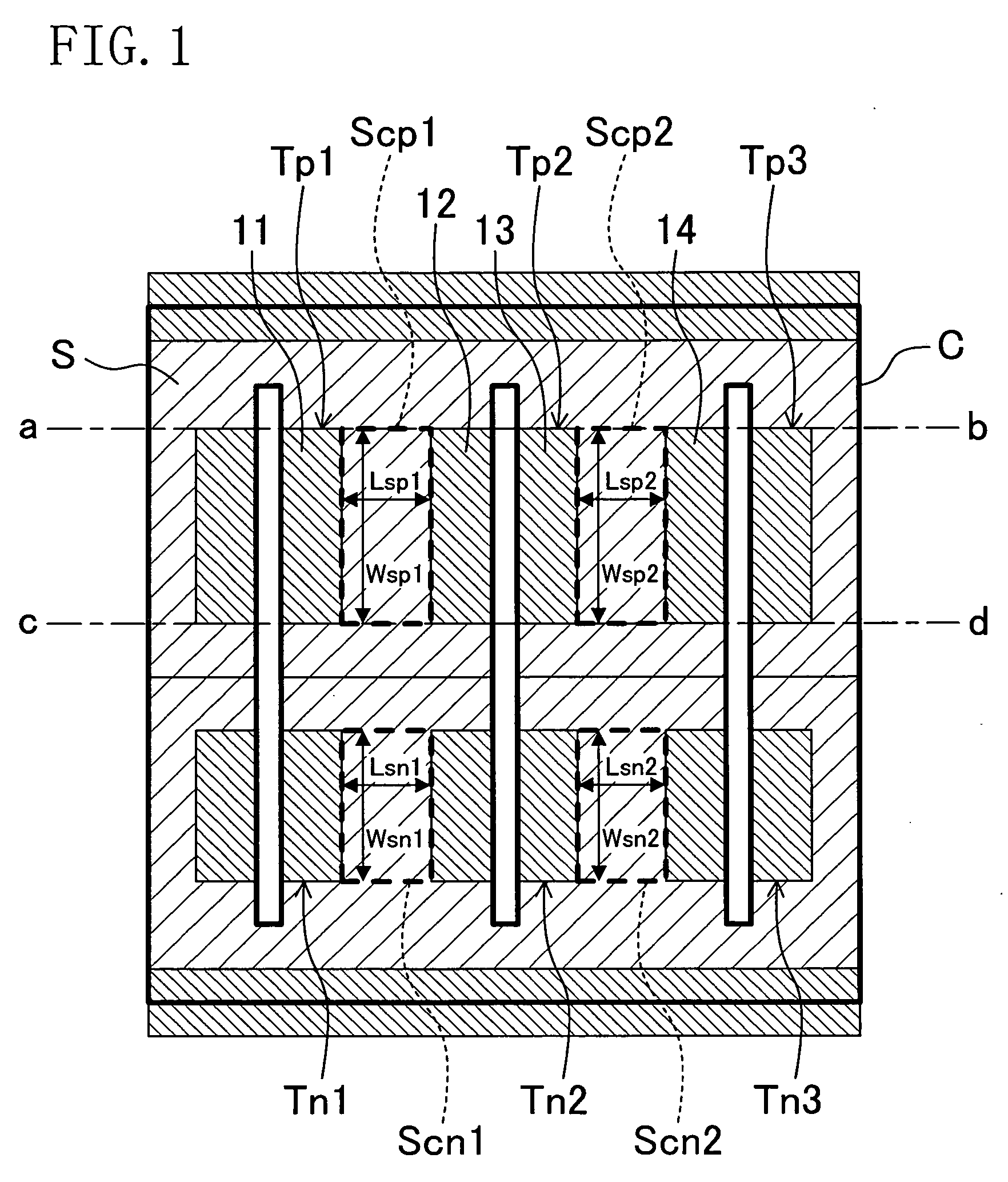Cell and semiconductor device
a cell and semiconductor technology, applied in the field of semiconductor devices, can solve the problems of difficult to secure the design accuracy of cells and lsi, insufficient accuracy cannot be secured with the conventional transistor model, and difficult detailed modeling, etc., to achieve suppressed variations in transistor characteristics
- Summary
- Abstract
- Description
- Claims
- Application Information
AI Technical Summary
Benefits of technology
Problems solved by technology
Method used
Image
Examples
embodiment 1
[0057]FIG. 1 is a plan view showing an example of a cell structure according to embodiment 1 of the present invention. As shown in FIG. 1, a cell C includes P-type transistors Tp1, Tp2 and Tp3, N-type transistors Tn1, Tn2 and Tn3, and a device isolation region S. The P-type transistors Tp1, Tp2 and Tp3 have an equal gate width. The N-type transistors Tn1, Tn2 and Tn3 have an equal gate width.
[0058]In FIG. 1, the P-type transistor placement region includes an impurity diffusion region 11 (first impurity diffusion region) which is a constituent of the P-type transistor Tp1 and an impurity diffusion region 12 (second impurity diffusion region) which is a constituent of the P-type transistor Tp2. The impurity diffusion regions 11 and 12 are provided side by side in the gate length direction with the device isolation region S interposed therebetween. The impurity diffusion regions 11 and 12 constitute a diffusion region pair. Also, the P-type transistor placement region includes an impur...
embodiment 2
[0068]FIG. 4 is a plan view showing an example of a cell structure according to embodiment 2 of the present invention. As shown in FIG. 4, a cell C includes P-type transistors Tp1, Tp2 and Tp3, N-type transistors Tn1, Tn2 and Tn3, and a cell C2 includes a P-type transistor Tp4 and an N-type transistor Tn4.
[0069]Referring to FIG. 4, in the P-type transistor placement region, part of the device isolation region S between the impurity diffusion region 11 of the P-type transistor Tp1 and the impurity diffusion region 12 of the P-type transistor Tp2 is referred to as an isolation region portion Scp1. Part of the device isolation region S between the impurity diffusion region 13 of the P-type transistor Tp2 and the impurity diffusion region 14 of the P-type transistor Tp3 is referred to as an isolation region portion Scp2. The isolation region portion Scp1 has separation length Lsp1 and separation width Wsp1, and the isolation region portion Scp2 has separation length Lsp2 and separation ...
embodiment 3
[0074]FIG. 5 is a plan view showing an example of a cell structure according to embodiment 3 of the present invention. As shown in FIG. 5, a cell C includes P-type transistors Tp1 and Tp3, N-type transistors Tn1 and Tn3, a P-type dummy impurity diffusion region Ddump, an N-type dummy impurity diffusion region Ddumn, and a device isolation region S.
[0075]In FIG. 5, the P-type transistor placement region includes an impurity diffusion region 21 (first impurity diffusion region), which is a constituent of the P-type transistor Tp1, and the dummy impurity diffusion region Ddump (second impurity diffusion region). The impurity diffusion region 21 and the dummy impurity diffusion region Ddump are provided side by side in the gate length direction with the device isolation region S interposed therebetween. The impurity diffusion region 21 and the dummy impurity diffusion region Ddump constitute a diffusion region pair. The P-type transistor placement region also includes an impurity diffus...
PUM
 Login to View More
Login to View More Abstract
Description
Claims
Application Information
 Login to View More
Login to View More - R&D
- Intellectual Property
- Life Sciences
- Materials
- Tech Scout
- Unparalleled Data Quality
- Higher Quality Content
- 60% Fewer Hallucinations
Browse by: Latest US Patents, China's latest patents, Technical Efficacy Thesaurus, Application Domain, Technology Topic, Popular Technical Reports.
© 2025 PatSnap. All rights reserved.Legal|Privacy policy|Modern Slavery Act Transparency Statement|Sitemap|About US| Contact US: help@patsnap.com



